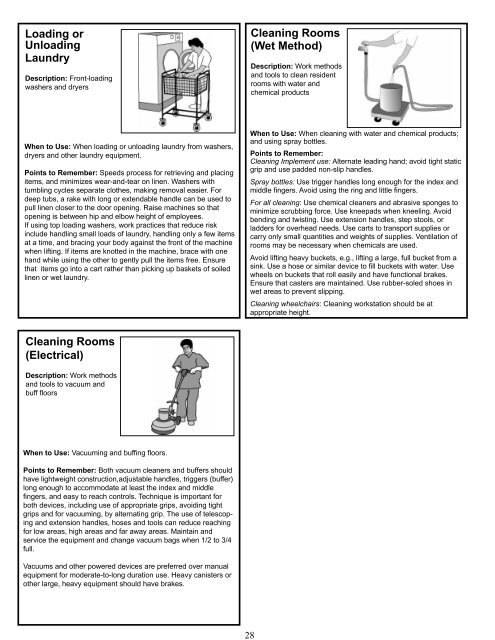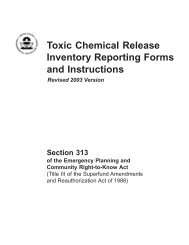Ergonomic Guidelines for Nursing Homes - Seton Resource Center
Ergonomic Guidelines for Nursing Homes - Seton Resource Center
Ergonomic Guidelines for Nursing Homes - Seton Resource Center
Create successful ePaper yourself
Turn your PDF publications into a flip-book with our unique Google optimized e-Paper software.
Loading or<br />
Unloading<br />
Laundry<br />
Description: Front-loading<br />
washers and dryers<br />
Cleaning Rooms<br />
(Wet Method)<br />
Description: Work methods<br />
and tools to clean resident<br />
rooms with water and<br />
chemical products<br />
When to Use: When loading or unloading laundry from washers,<br />
dryers and other laundry equipment.<br />
Points to Remember: Speeds process <strong>for</strong> retrieving and placing<br />
items, and minimizes wear-and-tear on linen. Washers with<br />
tumbling cycles separate clothes, making removal easier. For<br />
deep tubs, a rake with long or extendable handle can be used to<br />
pull linen closer to the door opening. Raise machines so that<br />
opening is between hip and elbow height of employees.<br />
If using top loading washers, work practices that reduce risk<br />
include handling small loads of laundry, handling only a few items<br />
at a time, and bracing your body against the front of the machine<br />
when lifting. If items are knotted in the machine, brace with one<br />
hand while using the other to gently pull the items free. Ensure<br />
that items go into a cart rather than picking up baskets of soiled<br />
linen or wet laundry.<br />
When to Use: When cleaning with water and chemical products;<br />
and using spray bottles.<br />
Points to Remember:<br />
Cleaning Implement use: Alternate leading hand; avoid tight static<br />
grip and use padded non-slip handles.<br />
Spray bottles: Use trigger handles long enough <strong>for</strong> the index and<br />
middle fingers. Avoid using the ring and little fingers.<br />
For all cleaning: Use chemical cleaners and abrasive sponges to<br />
minimize scrubbing <strong>for</strong>ce. Use kneepads when kneeling. Avoid<br />
bending and twisting. Use extension handles, step stools, or<br />
ladders <strong>for</strong> overhead needs. Use carts to transport supplies or<br />
carry only small quantities and weights of supplies. Ventilation of<br />
rooms may be necessary when chemicals are used.<br />
Avoid lifting heavy buckets, e.g., lifting a large, full bucket from a<br />
sink. Use a hose or similar device to fill buckets with water. Use<br />
wheels on buckets that roll easily and have functional brakes.<br />
Ensure that casters are maintained. Use rubber-soled shoes in<br />
wet areas to prevent slipping.<br />
Cleaning wheelchairs: Cleaning workstation should be at<br />
appropriate height.<br />
Cleaning Rooms<br />
(Electrical)<br />
Description: Work methods<br />
and tools to vacuum and<br />
buff floors<br />
When to Use: Vacuuming and buffing floors.<br />
Points to Remember: Both vacuum cleaners and buffers should<br />
have lightweight construction,adjustable handles, triggers (buffer)<br />
long enough to accommodate at least the index and middle<br />
fingers, and easy to reach controls. Technique is important <strong>for</strong><br />
both devices, including use of appropriate grips, avoiding tight<br />
grips and <strong>for</strong> vacuuming, by alternating grip. The use of telescoping<br />
and extension handles, hoses and tools can reduce reaching<br />
<strong>for</strong> low areas, high areas and far away areas. Maintain and<br />
service the equipment and change vacuum bags when 1/2 to 3/4<br />
full.<br />
Vacuums and other powered devices are preferred over manual<br />
equipment <strong>for</strong> moderate-to-long duration use. Heavy canisters or<br />
other large, heavy equipment should have brakes.

















